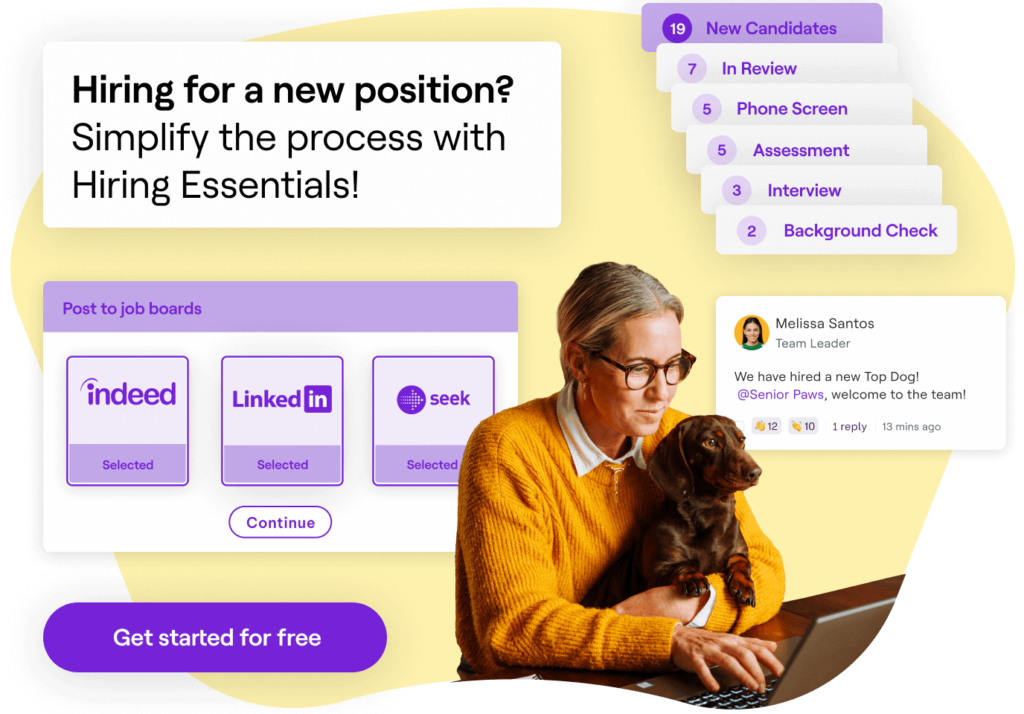What are passive candidates and how can you recruit them?
What exactly is a passive candidate and how do you recruit them? Read on as we explain everything you need to know about passive candidates.

Contents
We all know how difficult it can be to find that perfect hire for your business. The recruitment and hiring process can be a long and windy road, and sometimes it takes longer than initially intended. So what if we told you that you’re potentially missing out on one of the most common and effective ways to recruit great talent?
For most open roles, we often jump straight to thinking that they get filled via the traditional route. Post the job advertisement on a job board website and wait for standout applications to flood in. However, with the job market being more competitive than ever for employers, this method doesn’t consistently deliver and can accumulate costs.
Instead of waiting for the perfect candidate to apply for your open role, it’s time to start thinking of other ways you can attract standout talent. Research shows that 73% of candidates are passive candidates, making it the most common way to fill open roles.
Another important thing to note is that if you’re not currently seeking passive candidates, you could be missing out on one of the best ways to increase your talent pool. So what exactly is a passive candidate, and how do you recruit them?
Read on as we explain everything you need to know about passive candidates.

What is a passive candidate?
A passive candidate can be defined as a person who is not actively seeking a new job. However, a hiring manager or recruiter identifies that this person could be the right fit for an open position at another company.
From here, passive candidates get brought into the recruitment process via a direct invitation from a hiring manager or recruiter as they possess the right skills, qualifications and experience for the role they’re looking to fill.
What is the difference between active and passive candidates?
Active candidates are job seekers who are actively seeking new employment opportunities, usually via job boards, LinkedIn or other recruitment websites. They may be unemployed or unhappy in their current role and will be actively searching job boards, attending career fairs or contacting recruitment agencies.
On the other hand, passive candidates may not be actively seeking new employment but would consider a better job opportunity if it were presented to them.
Are active candidates better than passive candidates?
While active candidates can be a great way to fill an open position, active job seekers are often not as qualified as their passive counterparts.
This is partly because hiring managers can be more selective with the skillset of a potential candidate when sourcing from a pool of passive candidates. With active job seekers, hiring managers often have to take whoever applies as they’re actively searching for new employment.
Passive candidates often have a wealth of experience or knowledge in niche areas or have highly sought-after skills. These qualified candidates are usually found in technical fields, such as technology and engineering, healthcare or manufacturing fields, or areas where there are skill shortages.
This is where recruiting passive candidates comes into play. By sourcing and recruiting passive talent, you can access a larger and more qualified pool of candidates. For more insights, check out our article on 16 Transferable Skills To Look Out For During Recruitment.

Where can you source passive candidates?
Finding passive candidates is all about creating business relationships and expanding your professional network. Whether in person, through networking events, or virtually on social media via LinkedIn, it’s these personal connections that can help you source the best passive candidates the country (or world!) has to offer.
Passive candidates require hiring managers (or anyone from the business) to actively seek out candidates and top-tier talent for open positions. This involves looking for potential candidates with the right skills and experience who may be a good fit for the company.
There are many ways you can recruit passive candidates, either digitally, face to face or even by leveraging your current workforce.
1. Online channels and social media
One of the easiest ways to source passive candidates is to use LinkedIn or your professional network. Virtual meetups, LinkedIn groups or even Facebook business groups are a great way to connect with potential candidates.
These days, it’s easier than ever to find passive candidates via their skills or experience and send a quick message explaining the role. From here, you can gauge interest and understand if they’re interested in learning more about the role and opportunity available.
Social media sites have never made reaching out to potential candidates easier!
Helpful resource: Searching for the right words to reach out? Don’t worry, we created this handy passive candidate email template to make the outreach part easy.

Meetup.com has hundreds of virtual meetups to help you expand your professional network
2. Your existing candidate database
Many talent acquisition specialists use an applicant tracking system (ATS), and with good reason. If an employee submits an application to your organisation, even if they were unsuccessful, you’ll be able to add their profile into your database for future job opportunities.
This is very handy when you are experiencing a period of growth and have multiple job openings available.. Using an applicant tracking system means that you can search your job candidate database and find potential people to fill your open roles who have already expressed interest in working at your business. Simple!
3. Ask current employees for referrals
A cost-effective recruitment strategy is leveraging your current workforce to refer passive candidates. This can be through their friends, families, former colleagues, or their growing professional network.
The benefit of this strategy is that your employees would’ve already done half the sense checking for you! And it’ll cost much less than a recruitment agency or outsourced strategy.
With this said, it’s no surprise that an employee referral program is considered one of the most effective ways to source candidates for your business. Employee referrals are stronger overall than those who apply through a job board and have a longer average tenure.
To really engage your team in the employee referral program, we suggest setting up an incentive for when the new hire passes their probationary period.
This means that if employee referrals are successful, the referee will receive a reward. This reward can be monetary, time-dependent or whatever works for your business and your budget.
Pro tip: Thinking of implementing an employee referral program? Use this referral outreach template to reach out to potential candidates.
4. Use an Employer of Record
Looking to expand your talent pool and take your business international? Global Teams could be the solution you’ve been looking for.
Global teams is an employer of record service that helps with the local legislation while recruiting qualified candidates worldwide.
Hiring passive job seekers – is it really as easy as it sounds?
When you write it down on paper, hiring passive candidates seems like a surefire way to attract and recruit top talent into your business. It sounds easy. Reach out to your network who fit the job description, have a chat and hire them, right? Not exactly. In most cases, it’s not that simple. In fact, it’s quite the opposite.
One important factor to remember is that passive candidates are not actively seeking new employment. This means they can be more difficult to recruit than those who apply directly via the job board you advertised the role on.
You also need to remember that many other hiring managers are going to have a similar recruitment strategy to you, meaning passive candidates are in hot demand.
The reality is that passive candidates are most likely getting multiple LinkedIn messages a week about open positions, and there’s every chance that they’re very happy in their current job. This is where it’s important to ensure your employer branding and proposition stands out for all of the right reasons – which brings us to our next point.
Tips for Recruiting Passive Candidates
Strengthen your passive candidate recruitment strategy with these key tactics:
- Personalise Communications – Send thoughtful, tailored messages to build rapport, such as congratulating candidates on work milestones. Automated yet personalised messages about company benefits and openings can also be effective.
- Provide Value – Clearly explain why you’re reaching out and how the candidate would benefit. Share relevant insights, company resources, or industry reports to keep your company on their radar.
- Keep It Brief – Get to the point quickly. Use bullet points, infographics, or videos to enhance engagement while keeping messages concise.
- Use Multiple Channels – Different candidates prefer different platforms—email, LinkedIn, SMS. Identify and respect their preferred communication method to maximise engagement.
- Respect Boundaries – If candidates don’t respond after several messages, remove them from outreach. This maintains your employer brand and ensures compliance with privacy regulations like GDPR and CCPA.
- Refine Messaging Over Time – Adjust your outreach based on candidate interactions. Utilize email drip campaigns to automate and customize follow-ups based on engagement.
How can you stand out when seeking passive candidates?
When seeking passive candidates, it’s vital you stand out from the crowd with a compelling proposition. You should highlight your company culture, your employee value proposition (EVP), remuneration package and all of the perks the role will entail. A few things you should consider when crafting your passive candidate outreach strategy is:
- Be personal – the last thing you want to send is a generic message!
- Provide a high-level overview of the role and include the parts they’re looking for – remember that most will be scan-reading your message.
- Provide links to your website and make it easy for them to find out what your company is about.
- Follow up once (and once only!) if there is no response, and definitely don’t spam.
- Provide them with next steps and what to do if they’re interested in learning more.

The feeling when a passive candidate accepts your job offer.
The wrap up
Passive candidates are one of the most effective ways to bring top talent into your business. Although they’re not actively seeking a new job, the possibility of them being interested in a role when someone personally reaches out to them could be just what they need to make the best decision for their career.
It’s time to open up your talent pool and learn how you and your team can leverage the power of passive candidates!
Related Resources
-
 Read more: Guide to long service leave entitlements in Australia
Read more: Guide to long service leave entitlements in AustraliaGuide to long service leave entitlements in Australia
Understanding long service leave entitlements can be challenging. We share everything employers need to know about managing it.
-
 Read more: The $124,000 Cashflow Crunch: Small and Medium Businesses (SMBs) at risk under proposed Payday Super Requirements
Read more: The $124,000 Cashflow Crunch: Small and Medium Businesses (SMBs) at risk under proposed Payday Super RequirementsThe $124,000 Cashflow Crunch: Small and Medium Businesses (SMBs) at risk under proposed Payday Super Requirements
New Employment Hero modelling and research shows businesses will need an extra $124,000 in working capital on average to meet…
-
 Read more: From hiring mismatch to SmartMatch: 5 critical things your recruitment strategy is missing
Read more: From hiring mismatch to SmartMatch: 5 critical things your recruitment strategy is missingFrom hiring mismatch to SmartMatch: 5 critical things your recruitment strategy is missing
We’ve wrapped up five critical things your recruitment strategy might be missing so you can feel confident in your hiring…




















